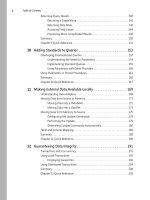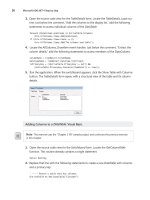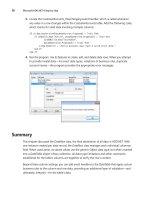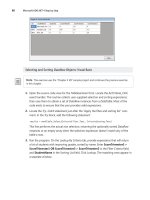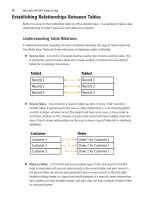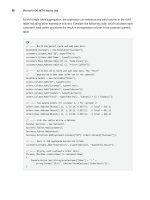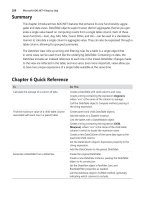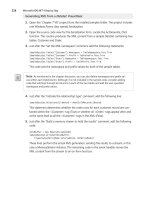Microsoft ADO .NET 4 Step by Step - p 33 pdf
Bạn đang xem bản rút gọn của tài liệu. Xem và tải ngay bản đầy đủ của tài liệu tại đây (554.2 KB, 10 trang )
296 Microsoft ADO.NET 4 Step by Step
Internally, LINQ uses the Where extension method and a lambda expression that expresses
the condition that filters the original collection.
C#
var results = transport.Where(tr => tr.SpeedClass == 1);
Visual Basic
Dim results = transport.Where(Function(tr) tr.SpeedClass = 1)
The Where clause supports all the conditional filtering elements you would expect from SQL,
including the comparison operators (>=, <, and so on), the logical operators (And, Or, and
Not in Visual Basic, &&, ||, and ! in C#), and support for complex expressions. Add parentheses
as needed to allow for conditional grouping of filters.
C#
var results = from tr in transport
where tr.SpeedClass == 1 && tr.Name.EndsWith("cycle")
select tr;
Visual Basic
Dim results = From tr In transport
Where tr.SpeedClass = 1 And tr.Name Like "*cycle"
Select tr
Sorting Results with the
Order By
Clause
The Order By clause sorts the projected and filtered results by one or more properties or
expressions. Each sort field in the comma-separated list that follows the Order By keywords
is processed from left to right. Optional Ascending (the default) and Descending modifiers ap-
pear after any of the sort fields.
C#
var results = from tr in transport
orderby tr.SpeedClass descending, tr.Name
select tr;
Visual Basic
Dim results = From tr In transport
Order By tr.SpeedClass Descending, tr.Name
Select tr
Chapter 17 Introducing LINQ 297
LINQ uses the OrderBy (or its OrderByDescending counterpart) extension method to sort a
projection on a field. When sorting on a single field, that method does a great job, but it
always assumes that the records to be sorted have not been previously sorted. If you opt to
develop a query using extension methods and try to string together multiple OrderBy meth-
ods, the results will be sorted onl y by the last (rightmost) OrderBy call.
C#
// This sorts by tr.Name (ascending) ONLY!
var results = transport.OrderByDescending(
tr => tr.SpeedClass).OrderBy(tr => tr.Name);
Visual Basic
' This sorts by tr.Name (ascending) ONLY!
Dim results = transport.OrderByDescending(
Function(tr) tr.SpeedClass).OrderBy(Function(tr) tr.Name)
To preserve the ordering imposed by earlier calls to OrderBy or OrderByDescending, LINQ
provides the ThenBy and ThenByD escending extension methods. This pair sorts results just
like their OrderBy complements, but they do so in conjunction with and subordinate to prior
sorting requests.
C#
// This sorts by SpeedClass (descending), Name (ascending).
var results = transport.OrderByDescending(
tr => tr.SpeedClass).ThenBy(tr => tr.Name);
Visual Basic
' This sorts by SpeedClass (descending), Name (ascending).
Dim results = transport.OrderByDescending(
Function(tr) tr.SpeedClass).ThenBy(Function(tr) tr.Name)
Selecting Linked Results with the
Join
Keyword
As in standard SQL, LINQ supports queries that combine results from two or more object col-
lections. LINQ has direct support for inner joins and cross joins, and indirect support for left
outer joins through the generation of hierarchical query results. Standard LINQ queries do
not support right outer joins and full outer joins.
298 Microsoft ADO.NET 4 Step by Step
To build a cross join, which generates all possible combinations of two incoming collections,
simply include both of the collections in From clauses. Visual Basic allows multiple comma-
delimited sources in the From clause; in C#, you must provide distinct From clauses.
C#
var results = from tr in transport
from sp in speed
select new { tr.Name, tr.SpeedClass, SpeedName = sp.Name };
Visual Basic
Dim results = From tr In transport, sp In speed
Select tr.Name, tr.SpeedClass, SpeedName = sp.Name
To change this cross join into an inner join (which includes only those record combinations
that match based on a condition), add a Where clause that indicates the relationship between
the two collections in the From clause.
C#
var results = from tr in transport
from sp in speed
where tr.SpeedClass == sp.ClassID
select new { tr.Name, tr.SpeedClass, SpeedName = sp.Name };
Visual Basic
Dim results = From tr In transport, sp In speed
Where tr.SpeedClass = sp.ClassID
Select tr.Name, tr.SpeedClass, SpeedName = sp.Name
You can also create inner joins using the Join clause, which is a syntax closer to standard SQL
JOIN syntax. Similar to From, Join identifies a collection and its range variable, but it also in-
cludes an On clause that documents the joined fields.
C#
var results = from tr in transport
join sp in speed on tr.SpeedClass equals sp.ClassID
select new { tr.Name, tr.SpeedClass, SpeedName = sp.Name };
Visual Basic
Dim results = From tr In transport
Join sp In speed On tr.SpeedClass Equals sp.ClassID
Select tr.Name, tr.SpeedClass, SpeedName = sp.Name
Chapter 17 Introducing LINQ 299
Note that you use the Equals keyword rather than an equals sign to pair the joined fields. For
multicolumn relationships, the On clause includes an And keyword that works much like the
conditional And clause.
LINQ can create hierarchical results, known as group joins, which simulate a database-level
left outer join. This type of joined query can include a subordinate set of results within one
field of each parent record. For instance, a group join between customer and order collec-
tions can generate a set of customer objects, each of which includes an Orders field contain-
ing a full collection of orders for that customer.
The syntax to produce a group join parallels that of a standard inner join, but you add the
Group keyword just before Join (Visual Basic only). An additional Into clause defines the
columns or properties of the subordinate collection. Within this clause, the special Group
keyword refers to the entire collection (again, Visual Basic only).
C#
// Generates a set of speed records, with each record
// containing the speed record name plus a "Members"
// property that is itself a collection of transport
// records associated with the parent speed record.
var results = from sp in speed
join tr in transport on sp.ClassID equals tr.SpeedClass
into Members
select new { SpeedGroup = sp.Name, Members };
Visual Basic
' Generates a set of speed records, with each record
' containing the speed record name plus a "Members"
' property that is itself a collection of transport
' records associated with the parent speed record.
Dim results = From sp In speed
Group Join tr In transport On sp.ClassID Equals tr.SpeedClass
Into Members = Group
Select SpeedGroup = sp.Name, Members
Limiting the Queried Content
In Visual Basic, LINQ includes several SQL-style keywords that limit the amount of data re-
turned by its queries.
The Distinct clause removes duplicate rows from the results. It typically appears after the en-
tire Select clause in Visual Basic. C# supports Distinct only in its extension method form.
300 Microsoft ADO.NET 4 Step by Step
C#
var results = (from tr in transport
orderby tr.Wheels
select tr.Wheels).Distinct();
Visual Basic
Dim results = From tr In transport
Select tr.Wheels Distinct
Order By Wheels
The Skip and Take clauses let you generate paged results, returning a limited number of ob-
jects in the output collection. Each keyword is followed by a numeric count that indicates the
number of records to skip (Skip) or include (Take). You can use either or both of these clauses
in your query. Using the Take clause alone parallels the functionality of the TOP keyword in
SQL Server.
C#
// Use extension method form in C#.
var results = (from tr in transport
select tr).Take(5);
Visual Basic
Dim results = From tr In transport
Take 5
Because LINQ queries are processed in the order in which their clauses appear, you will prob-
ably want to use an Order By clause before applying either Skip or Take, not after.
The Skip While and Take While clauses work just like Skip and Take, but rather than a number,
each accepts a conditional expression applied to each successive instance in the generated
query results.
Some of the extension methods associated with the IQueryable interface can also be used
to limit the results. They are applied to the completed query when using the SQL-like syntax.
When using LINQ’s extension method syntax, they appear as additional methods on the end
of the statement, as was done with the C# samples for Distinct and Take.
C#
// Returns just the first result, not a collection.
var result = (from tr in transport select tr).First();
// Counts the returned records.
int result = (from tr in transport select tr).Count();
Chapter 17 Introducing LINQ 301
Visual Basic
' Returns just the first result, not a collection.
Dim result = (From tr In transport).First
' Counts the returned records.
Dim result As Integer = (From tr In transport).Count
Summarizing Data Using Aggregates
LINQ includes several data aggregation functions that summarize data across the entire
result set or within subgroups when used with the Group By clause.
In Visual Basic, if a query exists only to generate a single aggregate value, replace the From
clause with an Aggregate clause. It starts out just like the From clause, with its source collec-
tion name and its range variable. This is followed by an Into clause that indicates the summary
function.
Visual Basic
' What is the maximum wheel count on any vehicle?
Dim result As Integer = Aggregate tr In transport
Into Max(tr.Wheels)
You can also use the extension method form of Max (or other aggregates), which works in
both Visual Basic and C#.
C#
// What is the maximum wheel count on any vehicle?
int result = transport.Max(tr => tr.Wheels);
Visual Basic
' What is the maximum wheel count on any vehicle?
Dim result As Integer = transport.Max(Function (tr) tr.Wheels)
LINQ includes the aggregate functions common to most database systems: Count (or
LongCount, which is functionality identical to Count, but returns a System.Int64 value); Sum;
Min; Max; and Average. Two additional functions, Any and All, return a Boolean value indicat-
ing whether any or all of the objects in the collection passed some conditional query.
302 Microsoft ADO.NET 4 Step by Step
C#
// Do any vehicles have three wheels?
bool result = transport.Any(tr => tr.Wheels == 3);
Visual Basic
' Do any vehicles have three wheels?
Dim result As Boolean = Aggregate tr In transport
Into Any(tr.Wheels = 3)
The Group By clause collects aggregate summaries within unique and identifiable groups.
Use it instead of the Aggregate clause to summarize data by category. Like Aggregate, it in-
cludes an Into clause that lists the summary functions (useful in Visual Basic) or indicates the
target group identifier (C#). The comma-delimited list of fields used in categorizing the data
appears between the By and Into keywords. A special member of the created aggregate, Key,
presents the unique grouping value for each subsection.
C#
// Vehicles by wheel count.
var results = from tr in transport
group tr by tr.Wheels into g
orderby g.Key
select new { g.Key, HowMany = g.Count(tr => true) };
Visual Basic
' Vehicles by wheel count.
Dim results = From tr In transport
Group By tr.Wheels Into HowMany = Count(True)
Order By Wheels
In Visual Basic, the Group By class performs an implicit Select of both the grouping columns
and the aggregate results, so you don’t need to include your own Select clause unless you
want to further project the results.
Applying Set Operations
Table 16-1 in Chapter 16 includes some extension methods that perform set operations:
Union, UnionAll, Intersect, and Except. SQL-style LINQ queries do not have specific keywords
for these features, but you can still use the extension methods directly to combine multiple
collections. The following query adds the Union extension method to one query, passing a
second query as an argument:
Chapter 17 Introducing LINQ 303
C#
var allTheNames = (from tr in transport
select tr.Name).Union(
from sp in speed
select sp.Name);
Visual Basic
Dim allTheNames = (From tr In transport
Select tr.Name).Union(
From sp In speed
Select sp.Name)
The queries to be combined can be as complex as you want, but the results must be
merge-compatible.
Summary
This chapter provided a glimpse into LINQ and its capability to apply SQL-style queries to
ordinary .NET object collections. The clauses that form the basis of each query including
From, Select, and Order By parallel their SQL counterparts in both meaning and functionality.
Although there are some differences that stem from LINQ’s data-agnostic way of processing
information, the ability to use the familiar SQL paradigm directly in the syntax of the C# and
Visual Basic languages brings together two great data processing worlds to meet your data
management needs.
For added power, you can use the IEnumerable(Of T) and IQueryable(Of T) extension meth-
ods, among others, to enhance the processed results. Although not covered in this chapter, it
is possible to write your own extension methods that integrate into LINQ queries as first-class
processing features.
The next three chapters delve deeper into the specific flavors of LINQ that pertain to the
ADO.NET experience.
304 Microsoft ADO.NET 4 Step by Step
Chapter 17 Quick Reference
To Do This
Join two collections together with an ”inner join” Include the Join keyword in the LINQ query, specifying
the linked columns with the On keyword.
Alternatively, include both collections in the From clause;
use a Where condition to indicate the link.
Get a count of records in a query Use the Aggregate clause followed by an Into Count(x).
The argument to Count is a Boolean expression; use True
to include all records.
Return the results of a query minus any results
found in a second query
Use the Except extension method:
(query1).Except(query2)
Chapter 18
Using LINQ to DataSet
After completing this chapter, you will be able to:
Prepare a DataTable instance so that it uses the IEnumerable interface
Treat ADO.NET table values as first-class members of a LINQ query
Cast type-neutral column values as strongly typed query values
LINQ processes data from a variety of sources, but those sources must first be expressed in a
form that LINQ can use. For instance, LINQ expects that all incoming data be stored in a col-
lection, one that conforms to either the IEnumerable(Of T) or the IQueryable(Of T) interface.
The LINQ to DataSet provider endows ordinary ADO.NET DataTable objects with the ability
to participate fully in LINQ queries. It does this by adding the necessary LINQ requirements
to relevant ADO.NET classes. This chapter introduces these enhancements and shows you
how to employ them to extract data from data sets using the power of LINQ.
Understanding the LINQ to DataSet Provider
ADO.NET’s DataTable class, as a logical collection of data-laden objects, is the perfect can-
didate for inclusion in LINQ queries. Unfortunately, it exhibits two aspects that make it less
than useful with LINQ: (1) it implements neither IEnumerable(Of T) nor IQueryable(Of T), and
(2) the data values contained in each DataRow instance exist as System.Object instances
and only indirectly express their true types through DataColumn definitions.
To overcome these deficiencies, the LINQ to DataSet provider adds new extension methods
to both the DataTable and DataRow classes. These new features appear in the System.Data.
DataSetExtensions assembly (found in the System.Data.DataSetExtensions.dll library file).
The assembly defines two classes, DataTableExtensions and DataRowExtensions, that include
new extension methods for the DataTable and DataRow classes, respectively. For data tables,
there is a new AsQueryable method that acts as the gateway for bringing ADO.NET data into
a LINQ query.

